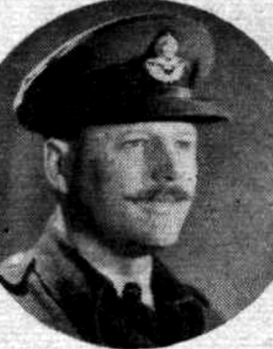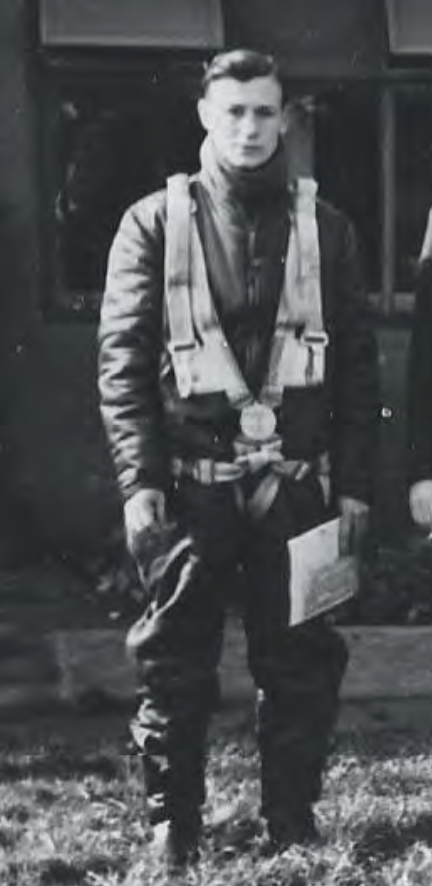
Historians will be grateful that Flt Lt ‘Scotty’ Scotney was as Efficient at handling a Camera as a pair of Browning Machine-Guns. On the Rotterdam Raid of 16th July 1941, Scotty decided that Spraying the Docks might cause Casualties among innocent Dutch Workers & Elected to wield a Leica instead. The net result was a collection of Photographs which was eagerly pounced upon by the Contemporary Press, showing Bomb Explosions on Nazi-Occupied Territory, & some evocative Shots across the Port Engine Nacelle of the last minutes of Wg Cdr Tim Partridge‘s Life.
The Tragic Loss of the CO made a profound impression on Scotty. He recalls:
‘Up until then, I hadn’t had too many frightening experiences. It was all a bit of an adventure really: all going nicely. It wasn’t until Partridge got the Chop that I began to think that maybe it wasn’t so funny & as time went on, we got even narrower squeaks & it became even less funny.’
By the end of his Tour of Operations on Blenheims, just before the end of the fearful Malta Detachment, Scotty’s nerves, like those of most of his Colleagues, were about as taut as the Strings of the Ukulele which he liked to play. But he had Survived, against appalling odds& the Authorities were canny enough to recognise that the best way of utilising Scotty’s valuable & hard-won Experience was by passing it on to others as an Air-gunnery Instructor.
Scotty obviously developed a taste for Teaching: by the time I met him in May 1983 he was the Headmaster of a London School. I was particularly impressed by his opening statement on that occasion: ‘Now, I won’t tell you anything that I’m not absolutely sure about. What I’m sure about, you can absolutely rely on.’
Subsequent cross-checking endorsed this Assertion.
Born in Croydon on 13th February 1921, Montague Stanley Scotney, like so many others, was not entirely happy with the Christian Names chosen for him. He confessed: ‘They used to call me “Scotty” on the Squadron. Growing up as a Lad with a name like Montague as a Christian Name – you have to Fight that off a bit!’ After leaving School, Scotty, by one of life’s strange coincidences, worked for 2-years for the same Firm & in the same place as did my Cousin, namely Lever Brothers in Unilever House. Their Paths would again Cross at No.17-OTU, Upwood. Scotty pre-empted his Call-up by Enlisting in the RAFVR on 5th July 1939, as an Untrained WOp/AG, for a nominal 5-yrs. Less than 2-months later, Britain declared War on Germany & Scotty was Mobilised at No.2 London Training Centre. (RAF Cardington, Beds)

Like many others, he was kept Waiting and it was not until after the start of the Blitzkrieg in the Low Countries that a place was found for him on the Course at No.1 Electrical & Wireless School, Cranwell. From there, Scotty Graduated as an AC1-Wireless-Operator, with the ability to handle Morse at a respectable 25 words per minute.
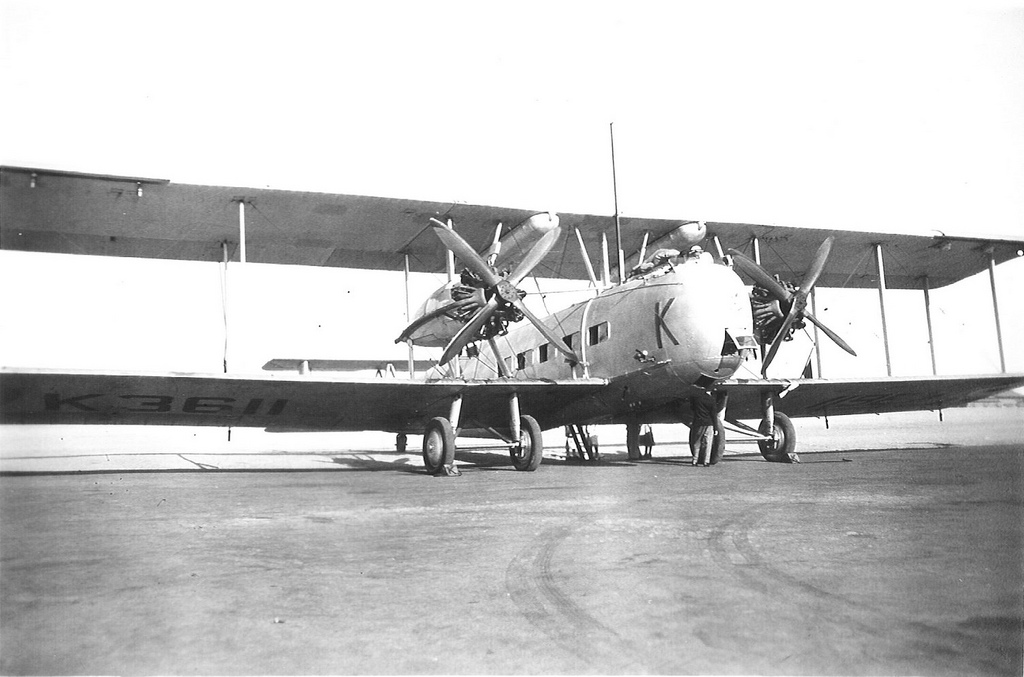
Inserted in Scotty’s Logbook is a cutting from a contemporary Newspaper, which depicts 9 budding W.Ops about to climb into a Vickers Valentia Biplane; the caption reads:
‘Young Apprentices at an RAF Station in the Midlands receive part of their Instruction in a huge Plane popularly known as “The Flying Classroom“.’
Scotty has underlined ‘popularly’: obviously, his 1st ever Excursion into the Air – in a Vickers Valentia K3601 – made a lasting Impact!

Other short Sorties on Westland Wallace II & de Havilland Dominie Aircraft completed the near 7-hr Flying Course.


On 9th August 1940, Scotty Enrolled on the Gunners’ Course at No.5-Bombing & Gunnery School, Jurby, Isle of Man. In only another 7-hrs of Flying – 12-Sorties – on Battle & Blenheim Aircraft, he became a fully-qualified Air-Gunner. At the end of the 1st week of September, Scotty commenced what was to prove a Marathon stay at No.17-OTU Upwood. Initially Flying in Avro Ansons, he completed the rest of the Course mainly on Blenheims; his monthly Logbook summaries are Signed by Sqn Ldr Peter F Webster.
Scotty Flew with a variety of Pilots at Upwood, not finally Crewing-up with Tom Jefferson until towards the end of the Course.
One Pilot left an indelible Impression on him, a certain Flying Officer Broadley. Scotty’s Logbook entry for 1st May 1941 simply records: ‘Shoot-up of March (War Weapons Week)’. The Interview reveals more: ‘Mad Devil he was. Did a Shoot-up of March with him. We did such a Tight Turn that I completely Blacked-out. I didn’t lose consciousness, but that was the 1st time I’d ever done that in a Blenheim! I remember he was a very nice person & I was pleased to see he was taken Prisoner & not Killed.’ Historical research is liberally sprinkled with such pitfalls: Ben Broadley of Rotterdam fame went through No.13-OTU Bicester somewhat earlier & on 1st May 1941 he was taking part in a Shipping Sweep whilst on 105-Squadron
Another of Scotty’s OTU memories qualifies for an entry in Laddie Lucas‘s Book Out of the Blue (Hutchinson & Co, 1985), in which fate is seen to intervene at appropriate moments in one’s lifetime. Scotty confesses:
‘We didn’t go through OTU very quickly. Not much flying; very little to do. So Bods used to whip off for Weekends, and we used to get people to stand in. This bloke called Eric Blomley, I remember, had just got married, and he was going off to see his wife; and he was on a Night-Flying Test; so I said that I would do it for him. Now, for some reason or another, I didn’t get this Blenheim but another Chap did, and this Aircraft Crashed. The Pilot & Observer were killed, and this Air-gunner got away with it. Now, I very clearly remember going to see this Air-gunner when he was taken to Sick Bay. He was badly Burned, and he was Lying down; and he said to me: – “You should have been here, you Bugger!“
The Course eventually finished, and Scotty joined 18-Squadron at Oulton on 28th June 1941. In at the Deep End, he was soon involved in Attacks on Shipping and Fringe Targets. Following his participation in the successful Raid on Le Havre on 10th July, Scotty pulled off the Air-gunners Dream when he was Credited with the Shooting Down of a Messerschmitt Bf 109. The Action took place during a North Sea Sweep off IJmuiden on 14th July, during which Tom Jefferson claimed Hits on a 6,000-Ton Merchant Ship. Scotty takes up the story:
‘We attacked this Ship, and then these Messerschmitts suddenly appeared. We were Flying up the Coast; one of them made a Quarter-attack, a traditional Quarter-attack: beautiful, Copy-book – he couldn’t have done it better. He was coming in, and he didn’t seem to care: he just came in. I remember Firing both Machine-Guns at him, and 1-Stuck; and I thought I’d better not bother trying to Toggle that, so I kept Firing Both off. Now, I don’t think he was Firing at us, and I’ll tell you why. My theory is that they were a Training Squadron and that they were so Cocky that they made this Attack on us quite Distinctly & Carefree and I Fired at him and he went off, but, before that, the one that I Shot Down: I didn’t see it go, but it’s in the Book & Signed-up: it Flew alongside, Parallel with me – now that’s the God’s honest truth! About as far away as that block of Flats [about 200-yds]. It was either Cockiness, or this Bloke was following another Blenheim that was Ahead of us, and was so Rookie & Inexperienced that he didn’t realise that he was presenting me with a Sitting Duck. I Fired at him, and then looked up and saw the other one making a Quarter-Attack on us, so I didn’t keep my eye on him. I’d Fired a long burst at him, but I thought I’d better be interested in what was going on Behind! Now, when we got back, they said that they saw that one go in, though I didn’t see him.’
Then came the Rotterdam Raid, which would radically change Scotty’s Outlook on Life; the Entry in his Logbook carries a Newspaper Cutting from the In Memoriam Section regarding Wg Cdr Tim Partridge.
On 5th August, after an Army Cooperation Exercise near Candlesby (Lincolnshire), Tom Jefferson finished up in a Ploughed Field after his Flaps had malfunctioned. (Is there some correlation between this and Tom’s Account of 14th September?). The WOp/AG’s feelings in such circumstances are always interesting to Record: ‘I was in the Turret; & one of the Jobs of the WOp/AG, as you were coming into the Final Approach, was to get out and undo the Accumulator. I suppose it was if you did Prang & the Electrics were Connected at that end, – as we were coming into Land, I felt an uneven movement in the Aircraft; as you’ll appreciate, if everything was going fine, no change of Engine Note etc (there was on 14th September!), no cause for Alarm; but immediately something strange happened, you were like this! As we were coming in, up went that Wing, like that, and it came back very slowly. I looked down the front, and I could see Jeff [Tom] & Ralph& they didn’t seem to be Panicking; & it didn’t come through on the Intercom, though it might have done afterwards. So I got out of my Turret & I was just bending down to undo this Accumulator, & there was a God Almighty Prang. I was chucked around like a ‘Pea in a Can‘. We had Pranged, but what I didn’t know was how we Crashed. I was in the Bowels, so to speak, of a Blenheim & I couldn’t see out. I had this previous intimation that something wasn’t right; and as soon as we Hit, I knew that we Crashed, but not how we Crashed. I remember vividly lying on my back & thinking: “Well, we’ve Pranged!” & I was waiting for the decisive Blow; because, for all I knew, we’d gone in & the chucking round was just a Prelude to Death. Now, this is true, I’ve told this before: a great feeling of Peace came over me, as I was lying on my Back. Whether this is in the mind, at the moment of Death, that conditions you to it, I don’t know. But that’s not my Imagination: this great feeling of Peace was very marked. [This is a Classic near-Death experience – see also Douglas Bader‘s Account of when he was in Hospital, after his Legs were Amputated & nearly Slipped away]. Then, of course, I let myself out of the Hatch; & Ralph up the front had been knocked about a bit: he spent 2 or 3-days in Hospital. I was bruised all over; although I Sat or Leant for about 2-weeks afterwards, I discovered new parts that had been Whacked! I don’t even remember being examined, though I suppose I must have been.’
Mid-August & Scotty was down at Manston for Channel Stop. It will be recalled that Tim Partridge‘s regular WOp/AG, Sgt Idris ‘Charlie’ Davies, had escaped Death on the Rotterdam Raid due to Compassionate Leave. Scotty remembers a conversation with him during the Manston Detachment:
‘When we were doing this “Channel Stop“, we used to have Standby Crews & we were called out for this Ship. I remember ever so clearly: we used to have these Irvin Jackets – thick Leather, Fur-lined; and just before we were getting kitted up to go, I remember saying to Davies: “What shall I wear for this, as it’s Low-Level?” He said: “You’d better put that Irvin on – it will Stop the Flak!” – Thank you!‘
On 19th August, Sgt Nickleson & Crew dropped Wg Cdr Douglas Bader’s Artificial Legs over St Omer Aerodrome. Though Scotty was not one of the 2-‘Rotterdam’ WOp/AGs who Flew on this Raid (Flt Sgt Antley & Sgt Allan), he has poignant Connections with the Canadian Pilot responsible for restoring Mobility to the Legless Ace. During these turbulent 2-Group days, Scotty kept one of the Battle Orders, which he amended from time to time. He explains:
‘When we were 1st Married & Living in Putney, I had this Battle Order, as I used to call it. They used to put them up in the Squadron, perhaps the Night Before: you would see, obviously not where you were going, but who was on the Battle Order for Tomorrow. You would have all your Crews & I think, all your Aircraft on it as well. I used to stub out my Cigarette against all those Blokes who got the Chop. I just kept it, until I met this woman who knew this particular Chap (Nickleson): & I gave it to her saying that he dropped Bader’s Legs & she should have it as a Souvenir.’
Nickleson‘s WOp/AG, Sgt Peirson, was one of Scotty’s friends. ‘Poor devil’, Scotty told me. ‘He used to give me his Wallet before he Flew on “Channel Stop“, saying: “If I don’t come back -“.
When the Inevitable happened on 20th September 1941, Scotty had a Grandstand view of the Tragedy. It was the one occasion when his Skill with a Camera let him down. During an Attack on Shipping off the Dutch Coast, Sgt Nickleson’s Aircraft, F for Freddie, was seen to have its Starboard Engine on Fire & Crash into the Sea. Scotty takes up the Story: ‘I had a Camera again – a Leica – and his Wing-tip, about that much of his Wing was sticking out of the Water, and I snapped it, but when I got back, none of the shots had come out: I’d done something wrong, but that memory has stayed very vivid with me.’
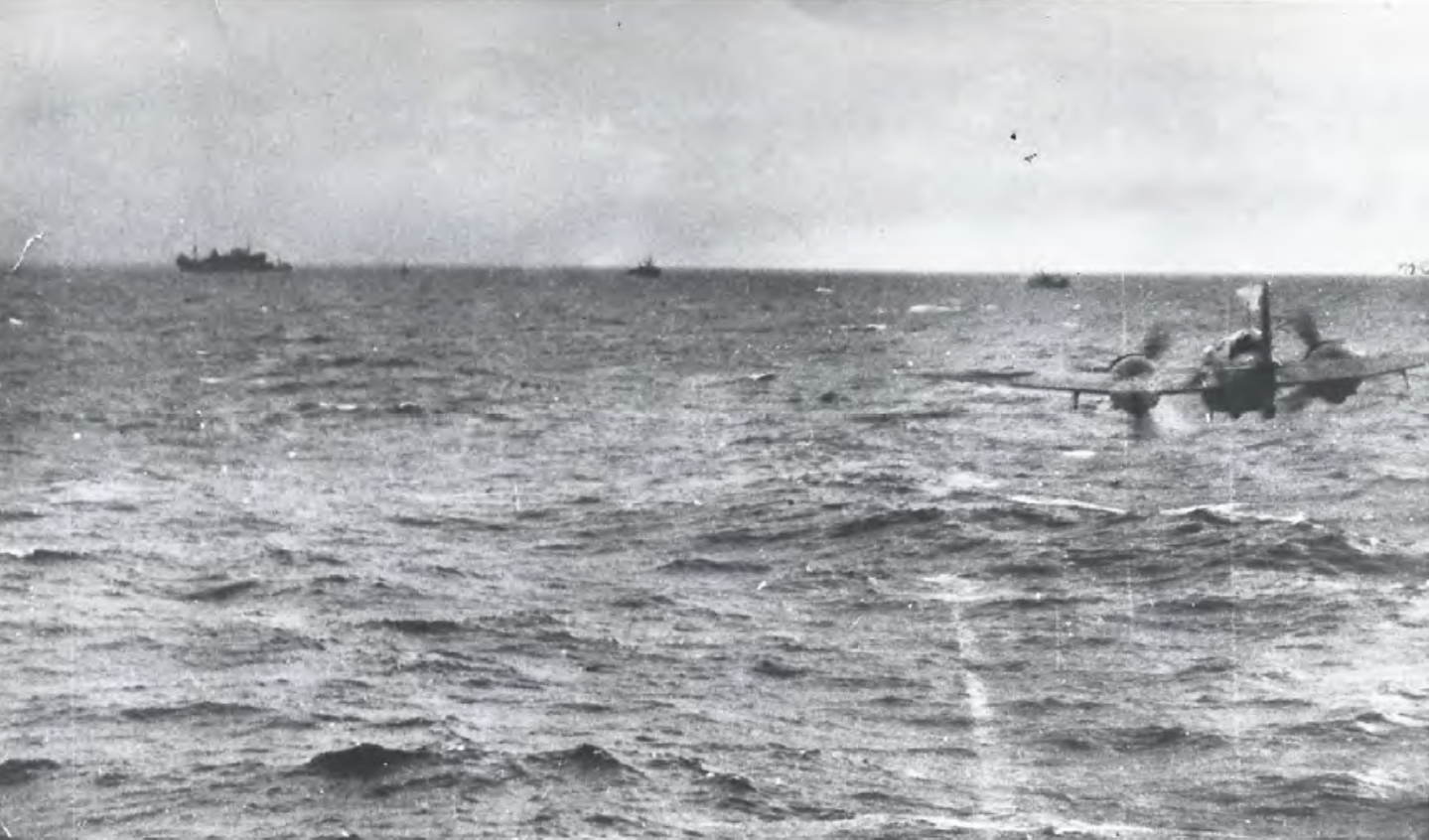
Scotty is understandably proud of his Sortie on 14th September 1941. The Scenario is a North Sea Shipping Sweep off The Hague. The Action Photograph of Tom Jefferson brushing the Waves whilst Lining up on a 10,000-Tonner captures Blenheim Operations in a nutshell. Scotty’s Logbook comments include: ‘Aircraft Hit by Flak from Escorting Vessels. Attacked by 3-Me.109s. Have a Bit of Wing.’
Around this time, much valuable Newsreel Footage was shot of Blenheim Operations & Scotty found himself elevated to the Status of a Film Star. He recalls:
‘They have made Films of Blenheim Activity: there’s one called “Daylight Sweep“, I think. I was on that one; it was shown on “Pathé News“. It was when we were on the Squadron. How I remember it was, they Filmed our Crew getting in & out of the Aircraft; & as is the wont of these Film people, you did 10 or 12-things all at once. I remember Climbing up onto the Wing & getting into the Turret & having to get out and do it all again. There was a Shot of a Crew being Briefed. I was apparently on that: I didn’t actually see the Pathé Gazette thing, but I was told that they saw me. It was shown in Cinemas & things like this & I had a Black eye at the time because I’d had a Contretemps with some Polish Sergeant-Pilot being Bolshy; and he threw 1-Punch & Knocked me Down & Out & he Knocked my friend Down & Out. It was an argument over some WAAF or Girl, or something like that: I actually stepped in to try & separate these 2, and he took a swipe & caught me & it went on to my friend – 2 in one!’

WOp/AGs, having made themselves ‘comfortable’ in their cramped Turrets, had one important function to perform before leaving Terra Firma – that of testing their Twin Browning .303 Machine-guns. The following accounts by 2-Air-Gunners on the Rotterdam raid nicely catch the flavour of those days. The 1st is submitted by Scotty Scotney, with reference to his Sispersal point down the side of a Road at Horsham St Faith: ‘And I’ll tell you something else that used to happen.’ he confesses. ‘And this is the God’s own honest truth. Do you know how I used to Test my Guns? I used to depress them where we were – by these Houses, by this Road – and fire a Burst into the Ground! That was accepted Practice! Now, it was stupid, but we did it. In the end, some of the Ricochets went through some of the Windows, as you can imagine, & there was a Great Kerfuffle. Then it was stopped.
Bob Carey remembers an Incident which took place at Watton, shortly after the Rotterdam Raid, when his Pilot had just taken Command of 21-Squadron: ‘Always, just at the last moment,’ Bob recalls, ‘I would check my Guns, against the Ground, & this day I had just asked Wg Cdr Kercher permission to check Guns. He said: “Go ahead.” At the time I pressed the Trigger – at that precise instant in time – a hand touched the Horizontal Stabilizer, a body leaped around & tried to get into the Aircraft. I hadn’t seen the Jeep drive up & it was Buck Taylor, the Station Warrant Officer. As he came round, the Tracers were virtually Fflying Straight at him. How he stopped, I don’t know – it must have been sheer force of Psychic or something – but he just froze in mid-air! He looked up; fortunately I had my Goggles on! He had a Message for Kercher. I got on the Intercom and said: “Warrant Officer Taylor, Sir.” Kercher cut back on the Throttles a bit & Buck climbed up & got inside. He dived down into the Cockpit. He was Ashen. I’d nearly Sliced him to Pieces. It was the closest I’d ever been to Killing someone [Bob obviously meant other than the Enemy!]. Well, he should never have done what he did. He should have known the Drill. At every Dispersal Pan, there was some point at which the Gunner checked his Fire with a 2 or 3-sec Burst. If he hadn’t Frozen, he’d have been a Dead man!’
Activities at a Bomber Station 1940
So to Malta. After their interesting Stop at Gibraltar, the Jefferson Crew were soon in the thick of the Allied Effort to prevent Rommel’s Supplies from getting through. Scotty’s Description of his Last Raid sounds about Par for the Course, as he vividly recalls:
‘Now, the most Dicey Period was Malta – without a Doubt. The very last Raid I did, there were 6 of us who went out; & of course, Jeff was Leading this Lot. I think they used to have Photo Reconaisance Unit Spitfires [more likely Maryland Is]
Go Out: sort out where there was something going over; and it was usually a Supply Ship taking stuff over to Rommel: & they were quite vital to Rommel at this time. Then he would say where it was; & they would send a Blenheim down on a Square Search, which we used to do. – I knew that I had to do what I had to do. – You knew your Luck was running out: it had to be Running Out – all you could see in front of you was just going on until you got the Chop! On this, my very Last Raid, there was this Merchant Ship with a Destroyer. Now, I saw the Smoke on the Horizon before anyone else did, but I said Nothing; let someone else Declare this one! So someone said: “Smoke on the Horizon!” We Attacked in pairs: old Jeff went in 1st & as we came in – again, this is a vivid memory – the Nose of the Destroyer came round; & we were right on this thing, to the extent where, in Levelling his Pom-Poms, the Water was churned up like Milk. The Ship was not all that Tall & we were Pulled up over it – you had to: you know the Technique with the 11-sec Delay Bombs – & then old Jeff stuffed the Nose Down. Now, I’m in the back, like this, obviously going that way & all I’m aware of then is the fact that suddenly – Oomph! – and both Engines cut out; and suddenly there was Nothing! Now, I knew we ended up at 200-ft at the most; & you see, as the Gunner, you’re not really at the Centre of things; I didn’t know if we were going in, or Jeff had been Hit, or what the Hell was happening. Then suddenly, Wham! – we pulled out! As we pulled out, the Bloke next to us had been Hit: he went off like a Rocket – I could see his Pale Blue Underbelly (they used to paint it very Pale Turquoise Blue in the Middle- East). Then, of course, when he got the Stall at the Top, he went Straight-in: Splash – that was that! We circled; watched the next 2 come in; I can’t remember if it was the 1st or the 2nd one, but another Blenheim did precisely the same thing – straight up, like that.’
Scotty asked me why this should happen. I assumed that many Pilots in those days trimmed Nose-up when Flying at Low-level, to cater for sudden Incapacitation. (After writing this, I was pleased to read that Terence O’Brien used to Wind the ‘Wheel of the Elevator Trim so as to create upward Pressure on the Stick. I always did this in Low-Level Attacks, right from early Blenheim days; it was a safety measure to ensure we Climbed rather than Dived if I Lost Control.’ (Chasing After Danger by Terence O’Brien: Collins 1990). Later Post-war Teaching recommended that an Aircraft be Trimmed hands-off for Straight & Level Flight.
It was a much relieved & very grateful Scotty who returned to the UK Aboard the Cunard White Liner Britannic early in 1942.

July 1942 marked the start of No.21 Air Gunners Instructors’ Course at Manby. After 3-weeks & some 11½-hrs Flying on Wellingtons, Scotty was a fully qualified AGI. What was more, he had passed out Top of the Course with a magnificent 88.5%. The Reward for the Top 2 was a Swift Posting to the Central Gunnery School at Sutton Bridge. Accompanying Scotty was his good friend, Freddie Colville. Freddie later Crewed up with another CGS instructor, Richard Trevor-Roper, who was Wg Cdr Guy Gibson’s Rear-Gunner on the Dams Raid. They were both Blasted out of the Sky during the Nuremberg Raid of 31st March 1944, Victims of German Major Martin Drewes’s Schräge Musik. The time spent at CGS produced its Crop of memorable Incidents, as Scotty recalls: ‘We used to Fly 4-Trips a day. What we were doing at Central Gunnery School was Liaising with the Top Fighter Pilots of the time. They would then be sent to Airfields around the Country to pass on newly acquired Skills. In the words of Group Captain Allan Wright “the CGS itself was the 1st of its kind in the World”. They would come & be Trained for Fighter-Piloting & you’d have all the Top ones there doing Instructing: Sailor Malan was there; Screwball Beurling; Johnnie Johnson. I would go up as Instructor & I’d be sitting beside the Pilot in the Wellington: I did about 600-hrs like that. There would be one of the Chaps on the Course in the Astrodome; another in the Tail. These Fighter Pilots would come in, doing their Bit; & we used to have Lightnings, Thunderbolts, Spitfires – the Lot. We lost 2-Aircraft like that: Fighters not Breaking-off & Crashing into the Wellington. One of them I was on caught Fire – I was in the Astrodome – & I suddenly saw a Flicker of Flame between the Port Engine & the Fuselage. I told the Skipper & Hared for the Exit & jumped out onto the Grass and the whole thing went Whoosh! Went up. The Fire Engine came, pointed Hoses & somebody said: “Right!” & all the clear Water came out at the Back – proper Fred Karno Outfit!’
Most Air-Gunners seemed keen on encroaching on the Pilots’ Reserve. Scotty got his chance on Wellingtons. He explains: ‘There was a Mate of mine called Sharman at CGS. He used to take me somewhere & would Climb out of the Pilot’s Seat & I would Climb in! I held it as Steady as I could, but I thought supposing one of the Engines were to Cut-out! It’s amazing what you got to learn through sitting next to a Wimpey Pilot for 600-hrs. I’m sure that if I’d ever had to do something in an Emergency, I’d have had a Fair Old Idea; not that I would have done it, but at least I wouldn’t have been Cold.’
December 1943 was a Highlight for Scotty. On the 1st day of the month he qualified as an ‘A’ Category Gunnery Leader, with an incredible assessment of 97%. Warrant Officer Scotney was Commissioned just 2-days later. No one would be surprised to learn that Scotty’s Expertise as an Instructor was fully Utilised until the end of Hostilities.
After the War, Scotty Trained as an Air Traffic Controller. He also experienced a temporary Elevation of Status. He admits, not a little proudly: ‘I was a Commanding Officer for a short time. Just a Line-shoot! That was at Bahrain. Our CO was Sqn Ldr Kee. Now, when he went off, it had to be the Senior Aircrew Bloke who took Charge, even though there were Wing Commanders & Squadron Leaders there; but I was the Senior Aircrew there, so I was CO for a week!’
The Final years of Scotty’s Career in the Service are best summed up in his own words:
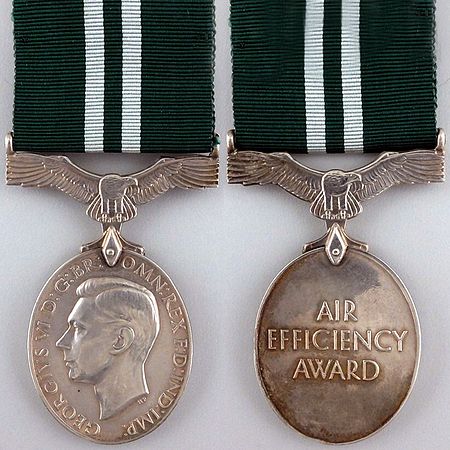
‘I was in the Volunteer Reserve after the War, & I was Flying from Fairoaks [No.18 Reserve Flying School: Anson Aircraft] until 1953. I was Crewed up with a BBC Producer, and a Chap who owned a Firm that did all the Flower Arrangements around the Big Buildings. They Stopped the Volunteer Reserve as such in 1953: the Flying, anyway. I could have Stayed in as an Intelligence Officer.’
By any standards, Scotty’s Contribution to the War Effort is of the highest Order. His only tangible recognition of his valuable Service to King & Country came in the form of the Air Efficiency Award – Granted to all those who have Served as Volunteers in the Air Forces of the Empire for a Period of 10- yrs.
The Scotney Family-at-War also included a Brother who, after Initially Training with the RAF in Canada, transferred to the Fleet Air Arm. In 1984, at the age of 60, he retired from ‘Dan Air’ (UK).

Scotty proved a 1st-Class contact & good friend. He is as keen as I to give Due Credit to the unsung Blenheim Heroes of yesteryear. Scotty Scotney’s Logbook page of the Rotterdam Raid of 16th July 1941. Note the iInsertion of the Press Cutting Obituary to his CO, Wg Cdr Tim Partridge (Scotty Scotney)
